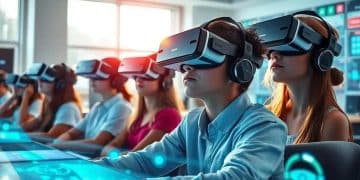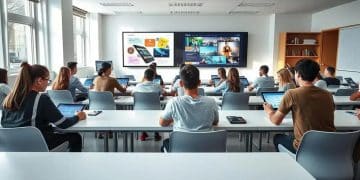Insights on virtual lab simulations: Transforming education
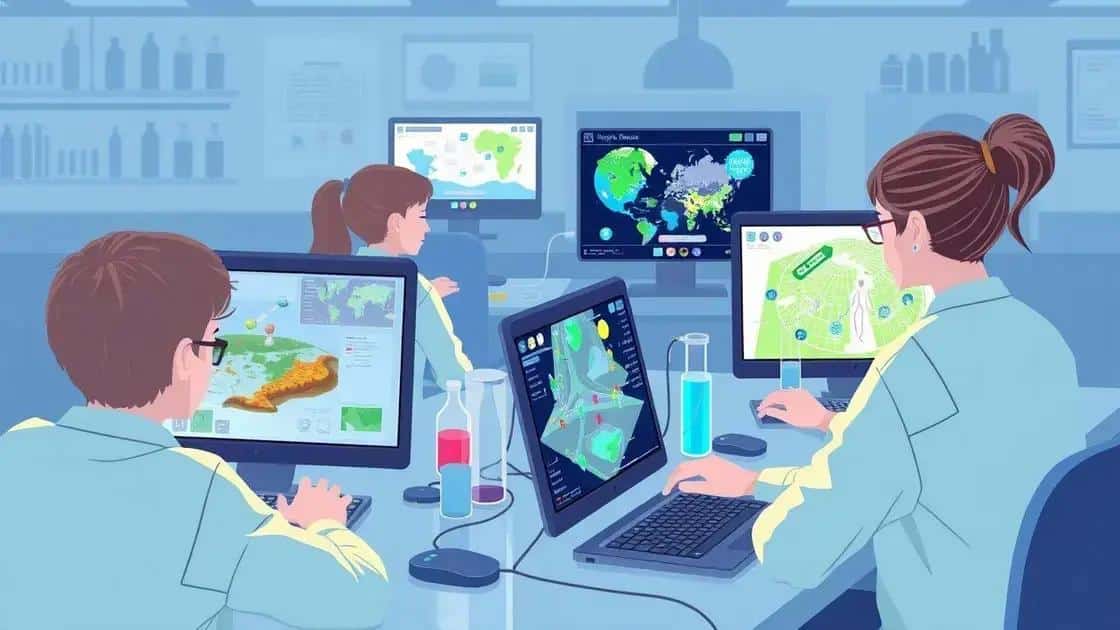
Virtual lab simulations enhance education by providing interactive learning experiences, enabling safe experimentation, and utilizing advanced technologies like AI and VR to cater to diverse learning needs.
Insights on virtual lab simulations are opening new doors in education, providing students with immersive and interactive learning opportunities. Have you ever thought about how these simulations can enhance your understanding of complex concepts?
Understanding virtual lab simulations
Understanding virtual lab simulations is crucial in today’s educational landscape. These simulations provide a unique opportunity for students to engage in hands-on learning without the constraints of a physical lab.
In virtual labs, learners can conduct experiments, explore complex concepts, and gain valuable experience in a safe environment. This innovative approach is reshaping how subjects like science and engineering are taught.
What are Virtual Lab Simulations?
Virtual lab simulations are digital environments that mimic real-world labs. They allow students to perform experiments using software, which can replicate the behavior of real equipment.
Benefits of Virtual Lab Simulations
- Accessibility: Students can access virtual labs from anywhere, making learning more flexible.
- Safety: Virtual labs eliminate the risks associated with physical experiments.
- Cost-effective: They reduce the need for expensive materials and equipment.
Moreover, these simulations enhance critical thinking and problem-solving skills. By interacting with virtual tools, students can develop a deeper understanding of theoretical concepts. They can experiment freely, make mistakes, and learn from them without the fear of real-world consequences.
As technology advances, the capabilities of these simulations grow. Tutorials and guided experiments can provide personalized learning paths suited to individual student needs. This tailored approach fosters greater engagement and retention of knowledge.
Examples of Virtual Lab Applications
Many educational institutions adopt virtual labs to supplement traditional learning methods. For instance, biology students can simulate dissections or microbiology experiments, while chemistry students can explore chemical reactions in a controlled setting. These practical applications prepare students for real-life scenarios and help bridge the gap between theory and practice.
Ultimately, embracing virtual lab simulations can revolutionize education, making learning more interactive and effective. By providing immersive experiences, we equip the next generation of learners with the skills they need to thrive in an increasingly complex world.
Benefits of virtual lab simulations in education
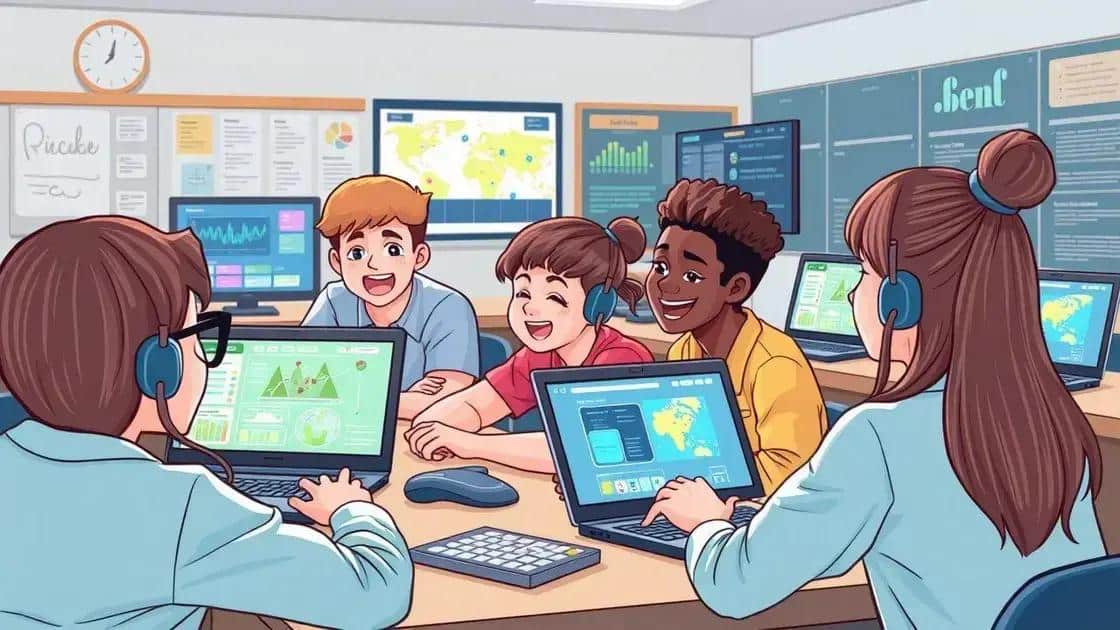
Benefits of virtual lab simulations in education are significant and multifaceted. These innovative tools provide unique ways for students to engage with complex concepts while enhancing their learning experience.
One primary advantage is the flexibility they offer. Students can access virtual labs anytime, gaining the ability to learn at their own pace. This accessibility is especially beneficial for those who may struggle with traditional classroom settings.
Enhanced Learning Experiences
Another major benefit is the interactive nature of virtual lab simulations. They allow students to experiment with different scenarios and see immediate results. This interactive approach fosters deeper understanding and retention of knowledge compared to passive learning methods.
- Real-world applications: Students can apply theoretical knowledge in realistic scenarios.
- Immediate feedback: Learners receive instant feedback on their experiments, which helps improve their skills.
- Collaboration opportunities: Virtual labs enable group work, promoting teamwork and communication skills.
Furthermore, virtual labs eliminate the risks and costs associated with physical laboratories. Students can conduct potentially hazardous experiments safely, allowing them to explore ideas without fear of danger or damage. This safe environment encourages experimentation and creative thinking.
Additionally, these simulations can be tailored to meet diverse learning styles. Educators can design specific tasks that suit individual student needs, enabling personalized learning experiences. This adaptability increases student engagement and motivation, as learners can work through challenges in a way that feels relevant and meaningful to them.
Cost-effectiveness of Virtual Labs
The cost savings associated with virtual lab simulations cannot be overlooked. Traditional labs require expensive equipment, chemicals, and materials. In contrast, virtual labs reduce these expenses dramatically, making them a viable option for schools and institutions with limited budgets. This affordability allows more schools to provide quality science education.
In summary, the benefits of virtual lab simulations in education are vast, from enhancing engagement and accessibility to promoting safety and cost-effectiveness. These tools not only enrich the learning experience but also prepare students for future challenges in an increasingly digital world.
How to effectively implement virtual lab simulations
How to effectively implement virtual lab simulations in education requires careful planning and execution. These simulations can greatly enhance learning, but it takes the right approach to make them successful.
First, it’s essential to choose the right platform that meets the specific needs of your curriculum. Look for virtual lab software that is user-friendly and aligns with your educational goals. Make sure it includes the subjects you want to teach and provides a range of experiments.
Training Educators
Educators should receive training on how to use these tools effectively. This training can include hands-on workshops or online tutorials. Understanding the features of the virtual lab will help instructors guide their students better. When teachers are comfortable with the technology, they can create a more engaging classroom environment.
- Encourage experimentation: Students should feel free to explore different experiments without the fear of making mistakes.
- Integrate into the curriculum: Virtual labs should complement traditional teaching methods.
- Use feedback: Collect feedback from students and teachers to address any issues and improve the experience.
Moreover, it’s important to establish clear learning objectives for each virtual lab activity. This clarity helps students know what they are expected to achieve. For example, define specific skills or knowledge they should gain after completing an experiment. Incorporating assessments can also help in measuring their understanding and engagement.
Another effective strategy is to encourage collaboration among students. Virtual lab simulations often allow for group work, which fosters teamwork and communication skills. By working together on experiments, students can share ideas, troubleshoot problems, and learn from each other.
Continuous Improvement
To maintain the effectiveness of virtual lab simulations, it’s crucial to regularly update the materials and tools based on technological advancements. Staying current ensures that students have access to the best resources available. Inviting experts to review the implementation can also provide valuable insights.
In conclusion, implementing virtual lab simulations requires thoughtful planning, continuous training for educators, and a focus on student engagement. By choosing the right tools and encouraging collaboration, educational institutions can create a dynamic learning environment that prepares students for future challenges.
Future trends in virtual lab simulations
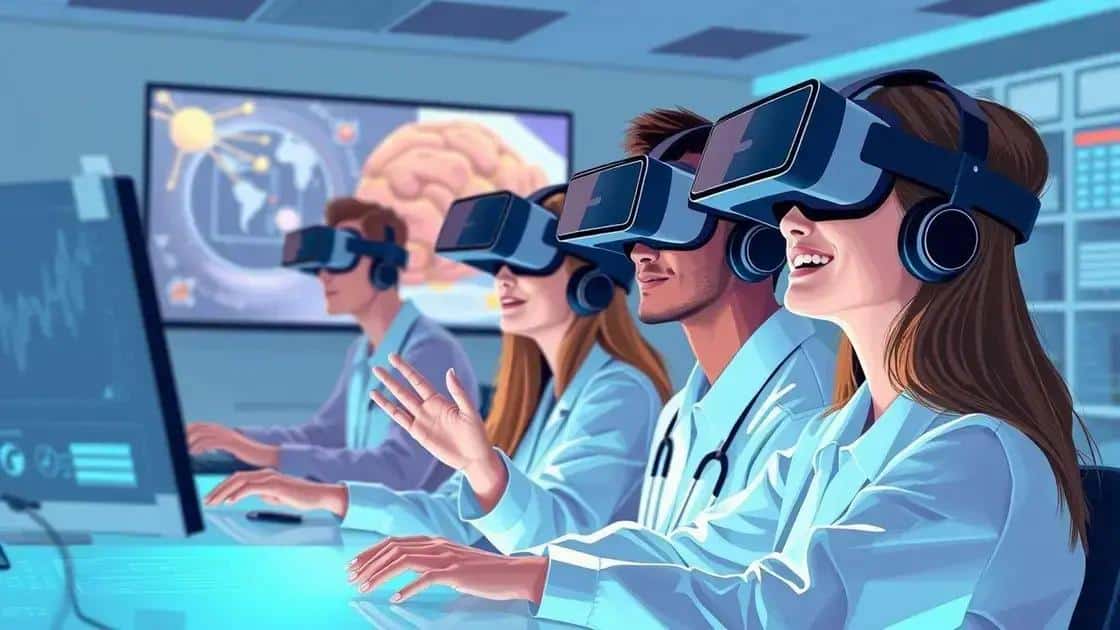
Future trends in virtual lab simulations are shaping the way education is delivered. As technology continues to evolve, these simulations are becoming more sophisticated and engaging for students.
One major trend is the integration of artificial intelligence (AI) into virtual lab simulations. AI can personalize learning experiences, adapt challenges, and provide instant feedback. This means students can receive tailored support based on their individual progress and learning styles, making education more efficient and effective.
Enhanced Interactivity
Another trend is the development of more immersive environments. Virtual reality (VR) and augmented reality (AR) are becoming increasingly popular in educational settings. These technologies allow students to enter a fully interactive lab environment where they can conduct experiments in a simulated physical space.
- Immersive learning: VR offers an experience that feels real, enhancing student engagement.
- Accessible locations: Students can explore labs and environments they may not have access to in real life.
- Collaborative features: Virtual spaces can accommodate group work, enhancing teamwork skills.
Additionally, the use of cloud technology continues to rise. This enables students to access virtual labs from anywhere, encouraging collaboration and learning outside traditional classroom settings. There are also plans for more devices to be compatible with virtual labs, making them available on smartphones and tablets.
As institutions move forward, there will be an increased focus on data analytics within virtual lab simulations. Educators can track student performance and engagement through analytics, providing insights that help improve teaching methods. This data-driven approach will enable a more responsive educational experience for students.
Global Collaboration
Finally, future trends will likely foster global collaboration. Virtual lab simulations can connect students from different parts of the world. Collaborative projects can enhance learning, enrich their educational experiences, and expose them to diverse perspectives.
In summary, the future of virtual lab simulations looks promising. With advancements in technology, these tools will continue to evolve, offering richer and more engaging educational experiences for students.
In conclusion, virtual lab simulations are revolutionizing education by making learning more engaging, interactive, and accessible. These tools open up new ways for students to experiment and explore complex concepts safely. As technology advances, we can expect even more sophisticated simulations that enhance personalized learning experiences. By embracing these innovations, educational institutions can prepare students for the future, fostering collaboration and creativity in a global learning environment.
\n
\n
FAQ – Frequently Asked Questions about Virtual Lab Simulations
What are virtual lab simulations?
Virtual lab simulations are digital environments that allow students to perform experiments and explore concepts safely and interactively.
How do virtual labs enhance learning?
They offer hands-on experience, immediate feedback, and the ability to experiment without risks, making learning more effective.
Can virtual lab simulations accommodate different learning styles?
Yes, they can be tailored to meet individual student needs, providing personalized experiences that cater to diverse learning preferences.
What role does technology play in the future of virtual labs?
Technology such as AI and VR will continue to improve the interactivity and accessibility of virtual labs, enriching the educational experience.

